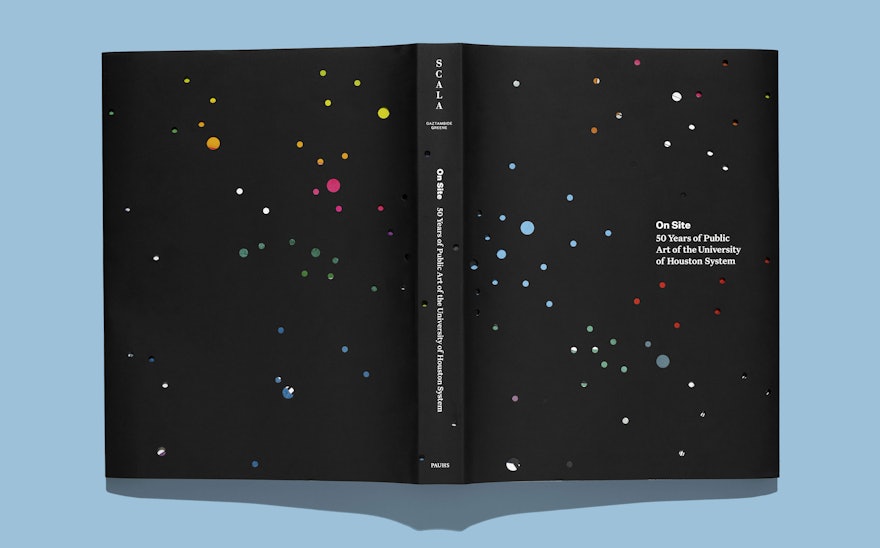In 1969 the University of Houston became the first state-funded university in Texas to establish a percent-for-art program. In this unprecedented commitment to excellence in the arts, UH began dedicating 1% of the construction costs of all new buildings to the acquisition of public art. Now, 50 years later, the expansive collection is one of the most critically-important of its kind. To celebrate this half-century commitment to public art, Pentagram Austin has designed the monograph On Site: 50 Years of Public Art of the University of Houston System. The oversized volume contains essays by Public Art of the University of Houston System (PAUHS) director and chief curator María C. Gaztambide and Museum of Fine Arts, Houston curator Alison de Lima Greene as well as a section exploring the history and significance of 42 of the most important pieces and an overview of more than 250 of the collections 700+ works.
At a time when public art was narrowly defined as sculpture situated outdoors, PAUHS worked to create a diverse collection whose purpose was to expand art’s accessibility to one and all. Operating under the dictums “Only Open to the Public” and “Exclusively for Everyone,” PAUHS inserts art into peoples’ everyday lives. This encourages discussion, reaction and fosters meaningful connections in the community—something artists themselves welcome and often seek. By working with local, national and internationally-renowned artists, PAUHS began acquiring large-scale outdoor sculpture, commissioning site-specific art and collecting other large and small works in various media. The book includes prominent artists like Andy Warhol, Frank Stella, James Surls, Alyson Shotz, Carlos Cruz-Diez and more who have contributed art to PAUHS over the last half century.
Published by Scala Arts Publishers, On Site features a matte black book jacket with die-cut circles which conceptually represent the various locations of the artworks spread across the five UH campuses. Through the holes in the jacket, you see snippets of the multicolored Euphonia by Frank Stella, a pillar of the collection, a detail of which is printed on the glossy hardcover and spills onto the flysheets. Stella’s Euphonia is one of the largest commissions in the collection, composed of collaged works on paper which cover the ceiling, mezzanine and catwalk of the UH Moores Opera House. Intended as a visualization of music and sound, the piece was a monumental collaboration between the artist and the community. Stella reflected fondly on the experience of working with local artists to create Euphonia, saying that he “wrote the score” for the piece, but his collaborators helped him play it.
Another distinguished PAUHS work featured in On Site is a set of Polaroid photographs by Andy Warhol. An avid photographer, Warhol used Polaroids to document his daily life and create reference material for his larger works. Many of the images are multiples of the same person in slightly different poses, often powdered with white to help obscure the details of the figure. Others are slice-of-life moments that reveal an intimate, more vulnerable side of the prolific artist. Pentagram Austin displayed 120+ of these Polaroids in a large double-gatefold. The reader can unfurl the pages and experience the photographs like they would if they visited the PAUHS collection.
The book is typeset in Untitled Sans and Untitled Serif, a pair of typefaces by Klim whose neutral aesthetic allows the artwork to be the focal point. The Sans and Serif are woven together in harmony throughout the volume, working in subtle ways to distinguish sections from one another. Where the lead essays are set in serif, the shorter essays in the Highlights section are set in sans. The use of the underlying grid also shifts between sections to allow for much larger images where the focus is on a singular piece as opposed to the front and back of book sections which focus on the collection as a whole.
On Site not only catalogues the collection, it celebrates the work, the artists and their impact on the community both local and abroad. The essays are largely arranged in alphabetical order by artist, range from poetry to first-person accounts to Q&As, to art-historical analyses. Also, the entire book is punctuated by large full spread details of the artworks. In this way, you see the PAUHS collection for what it is—an extremely diverse set of works which elicit a wide assortment of reactions and occupy disparate physical spaces and media. On Site embraces this variety and invites you to dive deeper.
A monumental book for a historic occasion, On Site is a vibrant depiction of the PAUHS collection at 50 years with an eye towards its bright future.

